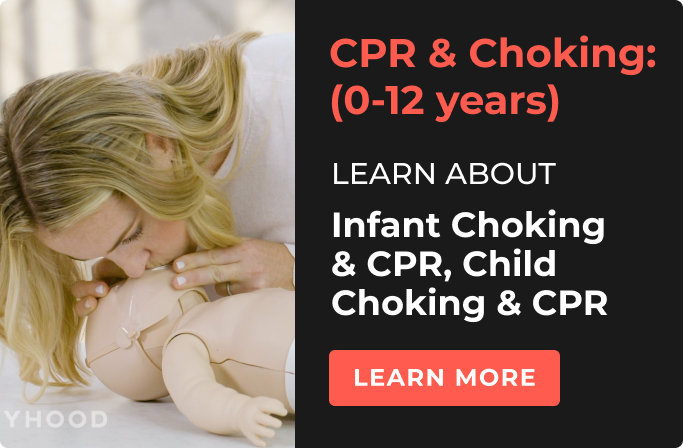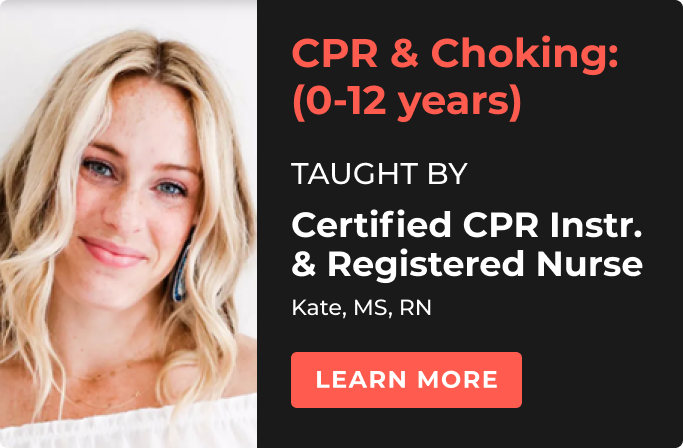By Alena Bowen
Splashing in streams, boating on the lake, playing at the pool— enjoying the water is one of the highlights of summer, but with a new baby, it can also be a safety concern. Keep reading for everything you need to know to keep your little one safe during warm weather months.
Learn how to save your child in the event of an emergency with our Safety 101: CPR and Choking course.
Stay Attentive.
The most important thing you can do to keep your baby safe around water is constant vigilance. Drowning can happen in an instant. Babies can drown in as little as an inch or two of water. Because they have limited control over their heads and necks, they aren’t able to move away from even a tiny amount of water covering their nose and mouth. They also change incredibly fast, a baby that can’t crawl over to the splash pad one day may very well be able to reach it the next.
Close, attentive supervision is the most effective way to prevent drowning in young children. If you are near water with your baby, even if it’s simply a filled-up bucket, put your phone down and avoid other distractions — they need to have your complete focus.
Take Inventory of Your Surroundings.
Whether in your backyard, a friend’s house or a public place, take inventory of anything that can hold water and empty it, if possible, when your baby is around. Common culprits include wading pools, splash pads, bird baths, decorative fountains or ponds, pots for plants, trash and recycling containers, wells, irrigation or drainage ditches, coolers with melted ice, and even toy buckets or bowls of water for pets. If it’s a source of standing water, it can be a hazard to your baby.
If you have a pool, it is critical to completely separate it from the house with a four-sided fence. This includes above-ground and inflatable pools. The American Academy of Pediatrics (AAP) recommends that pool fences should be at least four feet high, with no opening underneath or between slats more than four inches wide. It should include a self-closing and self-latching gate that opens away from the pool, with the latch at least 54 inches from the ground.
Learn CPR.
Unfortunately, accidents happen. The best thing you can do is at least be prepared just in case you find yourself in an unfavorable situation. One of the best ways to protect your baby, and your entire family, is to learn CPR (we have a course for that!).
This is a life-saving skill for any parent or caregiver that is well worth your time. If you don’t know how to swim, consider adding that skill as well. It’s important that you can safely help your baby in water if necessary.
Get Your Baby A Lifejacket.
On a boat or when visiting a natural body of water, like a lake or ocean, your baby should always wear a life jacket. Life jackets can also be a good choice in pools before and while your child is learning to swim.
A few things to keep in mind when choosing a life jacket:
• Life jackets for babies and infants should be labeled as an Infant PFD under 30 lbs (be sure to pick the right size based on your baby's weight), Coast Guard approved and Type II.
• Look for mandatory features for a safe baby life jacket such as a "heads-up" flotation pad and a strap that goes between the legs to keep the life jacket from sliding up.
• A breathable, comfortable fit that is easy to put on or take off a baby
Start Swimming Lessons Early!
The AAP recommends that children start swimming lessons as early as one year old to lower the risk of drowning. Not all babies will be ready at one, and that’s okay, but consider beginning swimming lessons as soon as you think your child is mature enough physically and emotionally.
Swim lessons for younger toddlers usually include the parent in the water but eventually children will be ready to take independent swim lessons.Parent-child classes at any age, however, can be a fun activity and bonding experience as well as a great way to get your child comfortable in the water.
During the summer or on vacation, from the backyard to the beach, playing in water is a fabulous family activity. To keep your family safe, follow the guidelines above, brush up on your infant and child CPR with our online course (it covers choking too, for extra protection), and enjoy all those baby splashes.
Want even more info? For water safety, general care best practices, and other life-saving measures, take a look at our Baby 101: The Parenting Prerequisite and our Safety 101: CPR and Choking courses.
About the Author
Alena Bowen writes about technology for work and family for fun. She lives in Denver, CO with three young children, a middle-aged husband, and an old cat. You can find her on Medium.




